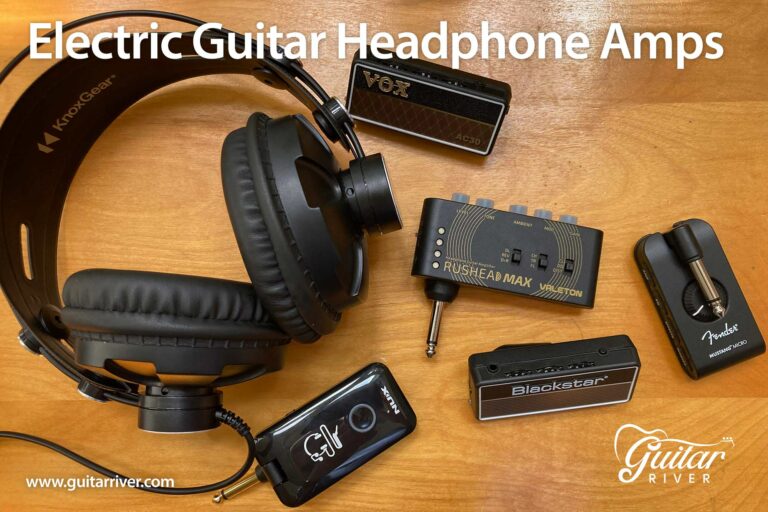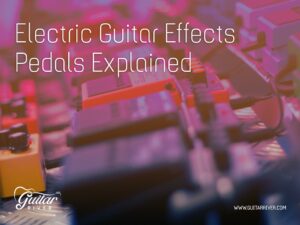Guitar River is reader-supported. We may earn a commission when you make a purchase using the links on our site.
Learn more.
Playing an Electric Guitar with Headphones: Headphone Amps Compared

There comes a time in every guitar player’s journey when it’s best to keep your playing to yourself. Perhaps your tone is closer to a vacuum cleaner than Megadeth. Or your significant other has heard the intro to “Enter Sandman” for the 300th time. It’s time to find a good pair of headphones and a headphone amp.
Playing electric guitar with headphones is easy with a headphone amp. A headphone amp is a small device that plugs into your guitar’s output jack. It replaces the guitar cable and amplifier and allows you to connect a pair of headphones directly to your guitar. Headphone amps include amp simulators and effects for practicing electric guitar.
So, can you get everything you need for practicing guitar from a headphone amp? Keep reading as we explore some options for headphone amps and determine what works best. You may end up deciding that a headphone amp will work for you.
Fender Mustang Micro Personal Guitar Amplifier
The Fender Mustang Micro is perhaps the top headphone amp at the moment. The amp combines all the amp tones and effects from the Fender Mustang amp series into a small package.
The Mustang Micro includes 12 amp models and 12 effects from the Mustang line of amplifiers. You essentially get a Mustang amp for a relatively low price. If all you want is a headphone amp for practice, this may be right for you.
Fender Mustang Micro Highlights
- 12 amp models with classic Fender tone
- Capable clean and high gain tones
- 12 effects, including compression, modulation, delay, reverb, and overdrive
- Headphone and USB-C out
- Easy to use controls on the device
- Stream songs with Bluetooth
Fender Mustang Micro Drawbacks
- No app control
- No metronome
- No drums loops or extras
Testing Notes
The Mustang Micro is easy to use and has an excellent sound. I appreciate the swivel input jack that allows the amp to fit easily into different output jacks and adjust to fit snugly against the guitar.
The controls are easy to use, but you can lose track of the settings. There are indicator lights for the amp, effects, EQ, and modification control. Each time you adjust the amp, the indicator light changes color. You must refer to the included key to determine which amp or effect is active.
Other reviews of the Fender Mustang Micro are overwhelmingly positive. Reviewers praise its tone, portability, and battery life.
Some reviewers complained of background hiss and did not like the controls and colored lights used to indicate the amp settings.
Overall, I think the Fender Mustang Micro amp is an excellent headphone amp. It’s portable, has a good battery life, and has fantastic sound. It’s capable as a practice amp, and you can use it as an input device for recording.
If you are looking for a suggestion, I recommend this headphone amp overall.
Boss WAZA-AIR Wireless Guitar Headphone Amp
The Boss WAZA-AIR is one of the more exciting headphone amps out there. It’s also costly when compared to other headphone amps.
The WAZA-AIR simulates the experience of playing a real amplifier, adding depth and a more realistic sound than a standard headphone amp. An integrated sensor tracks your head movements to add dimension and a directional element to the sound.
The Boss WAZA-AIR includes the same amplifier tones as the Katana series of amps and 50 different effects.
Given the price, we did not test this headphone amp. However, it’s worth noting that with the WAZA-AIR, you are essentially buying a high-quality set of headphones along with the amp. If you don’t already have a good pair of headphones, the WAZA-AIR may be a good option.
The reviews are mainly positive. However, some reviewers complained that the companion app would periodically lose connectivity and that the app was complicated.
The Boss WAZA-AIR looks promising, and if you want a realistic experience of playing with a physical amplifier, it could be the way to go. However, for the price, I would buy a stand-alone amplifier instead and choose one of the more affordable headphone amps.
Rockman GA Guitar Ace Headphone Amp
If you were around and playing guitar back in the 1980s, you probably remember these. The Rockman is a guitar headphone amp designed by Tom Scholz of the band Boston. Scholz’s company was later sold to Dunlop, who continues to manufacture a version of the amp.
The original Rockman X100 has the secret sauce that creates the distinctive Boston guitar sound. Aside from Boston, other bands and players, such as Def Leppard, Joe Satriani, and David Gilmour, used this amp to add character to their guitar sounds.
The Rockman Guitar Ace was introduced in 1990 and featured simplified controls and settings. The Guitar Ace lacks the reverb and chorus found on the X100 and the 1980s Rockman.
The new Rockman Guitar Ace from Dunlop has the same controls and settings as the Scholz R&D version and still delivers that retro vibe.
While not the original, the reissued Guitar Ace will give you a taste of the famous Boston guitar sound from the 1970s and 80s. You can still find the vintage versions on Reverb at a premium price.
If you want the Rockman sound but don’t want to pay the vintage gear price, another option is to try the Joe Satriani AmpliTube collection. I’ve tried it, and the “Boston 100” amp sounds great and is very close to the original.
However, there is something about the experience of using the physical device that the digital reproductions can’t quite match.
NUX Mighty Plug Guitar Headphone Amp
On paper, the NUX Mighty Plug is the best value of these selected amps. The amp includes an app for control, a metronome, simple drum loops, backing tracks, effects, amp simulators, and a speaker IR loader.
The Nux Mighty Plug has minimal controls on the device itself. There is a large button to select different presets. A colored ring around the button indicates which preset is active.
All of the adjustments and fine-tuning are made through the app. You can select different amps, effects, and speakers from there and overwrite the preset settings.
The sound quality is good, but I prefer the Fender Mustang Micro. The tremolo, hall reverb, and digital delay settings are fun to play around with. Some of the amp sims sounded too similar to me.
I had a few issues with the amp. I turned it on before everything was connected and experienced a loud feedback sound. Thankfully, I didn’t have the headphones on yet.
The default amp settings are all too loud for headphones. There is no master volume on the device, so you need to adjust the volume slider in the app each time you select a different amp.
There did not seem to be a way to adjust the volume of the backing tracks, making those difficult to use. Thankfully, the drum track volume is easily adjustable.
Overall, the NUX Mighty Plug is a good practice amp. It might be a good choice if you want something more adjustable than other amps on this list. However, the overall usability and volume issues keep me from loving it.
Vox amPlug 2 AC30 Guitar Headphone Amp
The Vox amPlug 2 AC30 is perfect for guitar players that don’t want to mess around with apps while playing. The controls are simple, with three main control wheels for volume, gain, and tone. There are smaller buttons to switch between chorus, delay, and reverb, and three levels of a tremolo effect.
The sound quality is surprisingly good. I was able to get a realistic amp tone without much effort. Digital amps can sometimes obscure your playing. The Vox amPlug 2 AC30 compliments and highlights the dynamics in your playing style.
I didn’t get much out of the chorus and delay effects, but the reverb sounded good along with the amp tones.
If you are looking for a basic headphone amp with an excellent sound and not a lot of extras, check out the Vox amPlug 2 AC30. These are also very affordable by comparison.
Blackstar amPlug 2 Fly Guitar Headphone Amp
The Blackstar amPlug 2 Fly has an identical design to the Vox AC30 amPlug (and other amPlug amps). There are three main control wheels for gain, volume, and tone. The tone control is Blackstar’s patented ISF control which switches between American and British voices of the amp.
As with the Vox amPlug, there is a control button for chorus, delay, and reverb. The second button switches between clean, gain, and high-gain amps.
The Blackstar amPlug2 Fly is similar to its larger sibling, the Blackstar ID:CORE amp. You can think of it as a mini version of that amp.
The sounds on this little headphone amp are impressive. If you want clean to high-gain sounds, this could be the ticket.
Overall, I preferred the tone of the Vox amPlug 2 AC30, but the Blackstar amp is equally as good. The choice will be a matter of personal preference.
Valeton Rushead Max Guitar Headphone Amp
This amp was mentioned in some Amazon reviews of the competitors and piqued my interest. At $30 or so, I thought it was worth checking out, considering the good reviews.
The Valeton Rushead Max is quite impressive given the price. The tone of this amp is on par or even better than the Nux Mighty Plug. It’s also as adjustable as the Nux.
The Rushead Max has a master volume, tone, reverb, delay, chorus, tremolo, and flanger. There are three amp selections: clean, overdrive, and distortion.
The amp uses a clever switch and dial control combination, allowing you to fine-tune and modify the tone. And there is no app required!
The Valeton Rushead Max is an excellent value and gives you a solid and fully-adjustable tone for a bargain price.
I recommend this amp over the Nux Mighty Plug. The Fender Mustang Micro is still my top choice, but I’m impressed with the controls and adjustability of the Rushead Max.
Headphone Selection
One thing to note with all these headphone amps is that the sound depends on the quality of your headphones. You’ll need a high-quality pair of headphones to take full advantage of these amps.
The Boss WAZA-AIR is a pair of headphones combined with the amp; otherwise, you’ll need to supply a set of headphones.
Wrapping Up
As you can see, playing an electric guitar with headphones is easy with the right equipment. And since these headphone amps range from about $30-$120, it’s also affordable.
Our top pick is the Fender Mustang Micro for its excellent sound quality and straightforward controls.
For an incredible value for customization without an app, check out the Valeton Rushead Max.
Finally, the Vox and Blackstar amPlugs are great choices for excellent sound and ease of use.
Whether you’re just looking for a headphone amp for practice or you want to experiment with different tones, any of these headphone amps would be a good choice.



